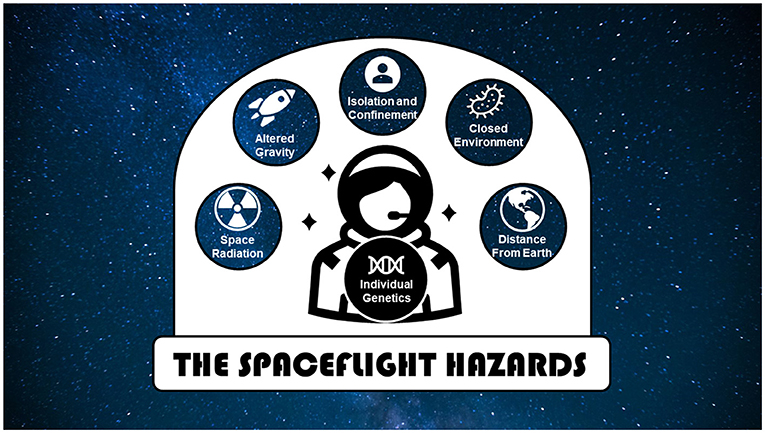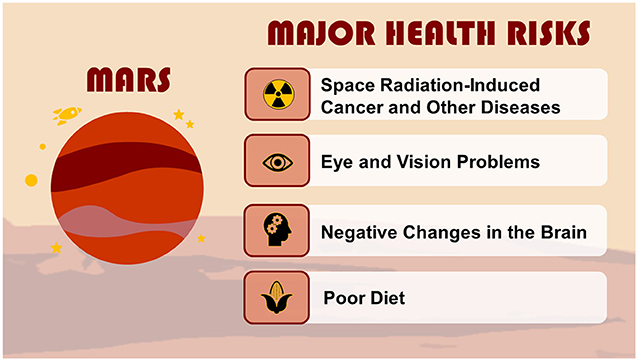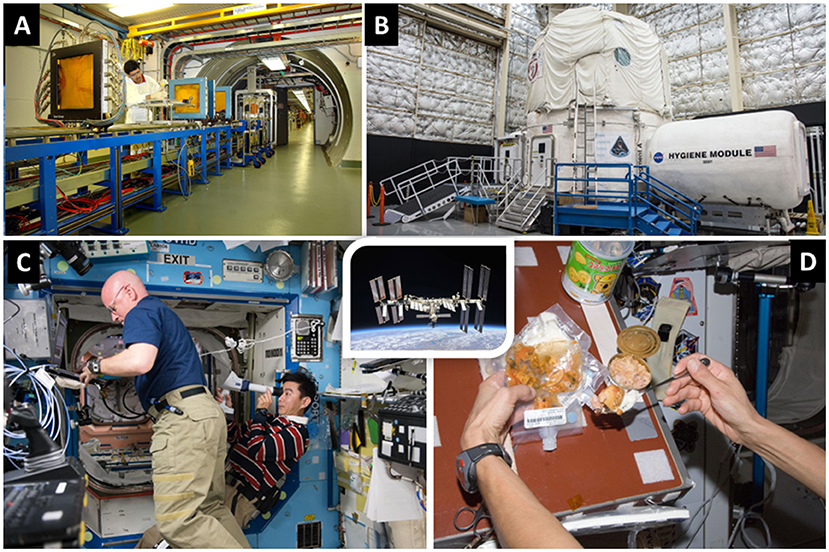Abstract
Space missions present several unique challenges to human health and performance, including space radiation, unique gravity fields, living with just a small group of companions in a small space for a long time, limited resources like food and water, and being far away from Earth. Since our last visit to the Moon, scientists at the National Aeronautics and Space Administration (NASA) have identified over 20 categories of human health risks that are related to these spaceflight hazards. Identifying the human health risks posed by space travel allows new science experiments to be designed and new knowledge to be gained, so we can ensure the health and safety of astronauts on their journeys of space exploration. In this article, we will set off on our own exploration mission to discover and learn about some of the main hazards and related health risks that space travelers will encounter.
Space Can Be Risky
In late 2022, the successful launch and return of the Artemis I Moon mission marked the start of a new and exciting chapter in human space exploration. Humans will soon set foot on the Moon for the first time in over 50 years, with plans to establish outposts on the Moon surface and in lunar orbit. Going to Mars is next, and the trip to Mars may take up to 3 years in space! Ensuring that space travelers are safe and have healthy bodies and minds is important for the success of these missions. As space travelers go further away from planet Earth, staying healthy becomes more challenging. For example, during a stay on the international space station
Spaceflight Hazards and Associated Health Risks
The spaceflight environment has a unique set of health hazards that space travelers must deal with. Spaceflight hazards include space radiation

- Figure 1 - Spaceflight hazards are a unique set of hazards present during space travel.
- Scientists are working to understand how the combination of these hazards, along with individual genetic differences, impact the health of space travelers.

- Figure 2 - There are many health risks from space travel, especially during long trips like a mission to Mars.
- Important health risks include space radiation-induced cancer and other diseases, eye and vision problems, changes in the brain that negatively affect behavior, mood, and thinking abilities, and a poor diet. Studying these risks and figuring out how to combat them will enable space travelers to have healthy bodies and minds on their trips to the Moon, Mars, and beyond.
Health Risk 1: Cancer and Other Diseases From Space Radiation
Did you know there is radiation in space? Space radiation is ionizing radiation
Cancer takes many years to develop, so it is unlikely to happen during a space mission. However, cancer could occur after a mission. Scientists are working to understand if cancer triggered by space radiation is more severe and more difficult to treat than cancer caused by ionizing radiation on Earth. They are also trying to figure out how to prevent it. Space radiation may cause health problems besides cancer, like problems with the heart, lungs, blood vessels, gut, or immune system (to learn more about heart health in space explorers, read more here and here). Space radiation may also have effects on the brain, causing problems with the ability to perform tasks, remember things, or learn new things (to learn more about how space radiation impacts the brain, read more here). To study the effects of space radiation, scientists use the National Aeronautics and Space Administration’s (NASA) Space Radiation Laboratory, a special facility where space radiation can be mimicked (Figure 3A, to learn more about studying space radiation effects here on Earth, read more here and here). Importantly, most of the studies on the effects of space radiation have been done in cell cultures and rodent models, so scientists are still trying to understand if these effects would also happen in human bodies.

- Figure 3 - Health risks from spaceflight can be studied on Earth in space analogs like: (A) the NASA Space Radiation Laboratory, located at Brookhaven National Laboratory in New York; or (B) the Human Exploration Research Analog located at NASA Johnson Space Center.
- These risks are also studied in space onboard the International Space Station (ISS) (middle). (C) ISS expedition NASA astronaut Scott Kelly (left) assists Japan Aerospace Exploration Agency astronaut Kimiya Yui (right) with eye and vision measurements. (D) An ISS crew member prepares a meal of various food items (Image credits: NASA).
Health Risk 2: Eye and Vision Problems
Do you or does someone in your family wear eyeglasses to see better? We have known for a long time that going into space can change an astronaut’s vision, so we give them several pairs of eyeglasses of differing power to take with them. More recently, scientists have identified an eye disease that is specific to spaceflight, called spaceflight associated neuro-ocular syndrome (SANS)
Health Risk 3: Changes in the Brain That Affect Behavior, Mood, and Thinking Abilities
Going to space for a long time can be pretty stressful. On a mission to Mars, space travelers will experience long periods of isolation, will be confined in a small space, and may have to go long periods of time without talking to people on Earth. These issues may cause problems with making decisions, performing tasks well, working together in a team, and handling stress. In severe cases, space travelers may feel depressed, anxious, or angry. Luckily, scientists have shown that there are habits that can reduce the stress of going to space. On the ISS, a laboratory in space where astronauts work and live (Figures 3C, D), sleeping well, exercising, journaling, communicating with loved ones, and thinking positively has helped astronauts reduce stress.
However, a journey to Mars will be more challenging than a mission on the ISS. Space travelers will be gone for much longer periods of time and they may not be able to communicate with people on Earth for long stretches. To study these conditions, scientists use a space analog
Health Risk 4: A Poor Diet
A poor diet has always been a concern for explorers. For example, scurvy, a disease caused by a lack of vitamin C, killed many sailors between the sixteenth–eighteenth centuries. Like sailors, space travelers will also need to ensure they are eating enough healthy foods that contain the vitamins and nutrients they need to survive and thrive. However, unlike sailors, space travelers do not have the option to stop at a port city and refill their food supplies. On the ISS, scientists have been studying the importance of good nutrition and the consequences of poor nutrition, as NASA prepares for longer journeys to the Moon and Mars (Figure 3D) [3]. Poor nutrition can cause many health issues, like poor bone health, reduced ability to think clearly, reduced heart function, and vision problems. Good nutrition may also help fight some of the negative health effects caused by the other spaceflight hazards. Some health conditions on Earth may also be linked to poor nutrition, so studying how a poor diet impacts space travelers is not only useful for a trip to space—it could improve the health of people on Earth, too.
Back to the Moon… and Beyond!
There are many hazards in the space environment that may impact the health of space travelers. These hazards may lead to a number of potential health problems. Research on space-related health risks will enable space travelers to have healthy bodies and minds on their trips to the Moon, Mars, and beyond! If you still want to learn more, and we hope you do, further information on these topics can be found on NASA’s website.
Author disclaimer
This work was prepared while ZP was employed at KBR/NASA Johnson Space Center. The opinions expressed in this work are the author’s own and do not reflect the view of the National Institutes of Health, the Department of Health and Human Services, or the United States Government.
Glossary
International Space Station (ISS): ↑ A large spacecraft in orbit around the Earth where astronauts can work and live.
Spaceflight Hazards: ↑ Hazards to human health and performance that are unique to space.
Health Risks: ↑ The risk of developing illnesses or unwanted changes in the body. Some health risks are important to think about for a long trip in space, like a trip to Mars.
Space Radiation: ↑ Energetic charged particles originating from the sun and galactic supernovae remnants.
Ionizing Radiation: ↑ Radiation with enough energy to break chemical bonds.
Spaceflight Associated Neuro-Ocular Syndrome (SANS): ↑ Eye and vision changes that may occur in astronauts during and after long-duration spaceflight missions.
Microgravity: ↑ Conditions occurring when the pull of gravity is small, and objects seem weightless.
Space Analog: ↑ Environments on Earth that are used to study conditions in space.
Conflict of Interest
The authors declare that the research was conducted in the absence of any commercial or financial relationships that could be construed as a potential conflict of interest.
Acknowledgments
This work was supported by the Human Research Program of the Human Exploration and Operations Mission Directorate of the National Aeronautics and Space Administration [JH], by the Human Health and Performance contract NNJ15HK11B [ZP], and by the NASA Langley Research Center Cooperative Agreement 80LARC17C0004 [KM]. Written informed consent was obtained from the individual(s) for the publication of any identifiable images or data included in this article.
Original Source Article
↑Patel, Z. S., Brunstetter, T. J., Tarver, W. J., Whitmire, A. M., Zwart, S. R., Smith, S. M., et al. 2020. Red risks for a journey to the red planet: the highest priority human health risks for a mission to Mars. NPJ Microgravity 6:33. doi: 10.1038/s41526-020-00124-6
References
[1] ↑ Auñón-Chancellor, S. M., Pattarini, J. M., Moll, S., and Sargsyan, A. 2020. Venous thrombosis during spaceflight. N. Engl. J. Med. 382:89–90. doi: 10.1056/NEJMc1905875
[2] ↑ NASA. The 5 Hazards of Human Spaceflight. NASA. (2018). Available online at: http://www.nasa.gov/hrp/hazards (accessed October 19, 2022).
[3] ↑ Patel, Z. S., Brunstetter, T. J., Tarver, W. J., Whitmire, A. M., Zwart, S. R., Smith, S. M., et al. 2020. Red risks for a journey to the red planet: the highest priority human health risks for a mission to mars. NPJ Microgravity 6:33. doi: 10.1038/s41526-020-00124-6
